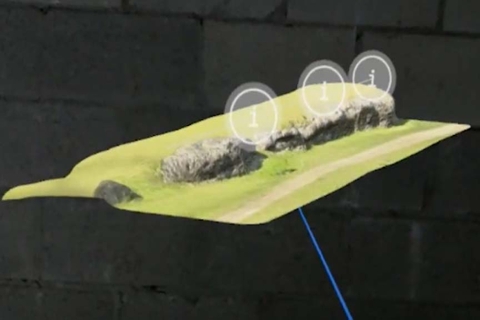 |
South Florida Mixed Reality Field TripsSouth Florida Mixed Reality Field Trips
Team: Art Gleason, Physics Dept: concept, project lead, 3D model creation
Sam Purkis, RSMAS: geoscience content
Fritz Hanselmann: RSMAS, archaeology content
Chris Mader, Amin Sarafrz, IDSC, and Douglas Fajardo, Tiffen Baker Xenneal
Description: Many UM academic divisions run local field trips, which we define as a collection of sites related by a common theme combined with supplementary educational material (maps, photographs, descriptions, samples, slides, etc..) Our objective was to explore ways that mixed reality, in general, and the Magic Leap headsets, in particular, could be used to enhance these field trips. We envision a framework into which any UM department/individual could place content for their own instructional needs, building up a large library of sites across the South Florida region over time in the process.
Video: https://youtu.be/8c7VwWwm_ls
|
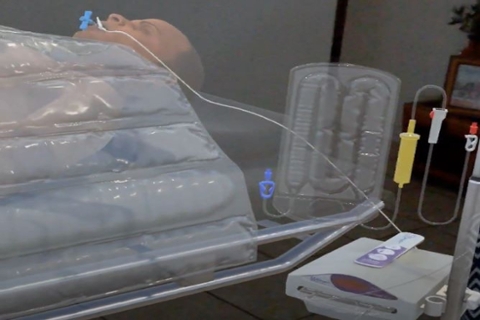 |
Mixed Reality Simulated "Escape OR" for Teaching in Anesthesia
Team: Greta Mitzova-Vladinov: Primary Investigator and Project Leader UM - SONHS side
Nicolas Alberti: Storyboard, Design, Development
Michael Mannino: Project Leader UM-IDSC side
Xennial Digital Studios: Development, 3D Modeling
Description: This project seeks to develop a mixed reality simulation “Escape Operating Room” for anesthesia equipment set up for nurse anesthesia students who have not been in the clinical environment and are not familiar with such equipment. The project will be evaluated for feasibility and adaptability of mixed reality for simulated anesthesia teaching activities.
Video: https://youtu.be/NST8m6DqV4k
|
 |
The Peri-Operational Experience (POE)
Team: Nicolas Alberti: Storyboarding, Designing, Development
Joel Zysman: Project Lead
Dr. Lee Kaplan: Stakeholder
William Cade: Decision Support Analyst, Survey Data Informant
Rebecca Lopez: Executive Assistant
Description: A guided tour, taking the patient through a step by step process of surgery day with 4 main environments which include intractable “Hotspots”.
Video: https://youtu.be/vjh7ZjliXAQ
|
 |
AR Statics
Team: James Giancaspro: PI; Storyboard Design, debugging, QA, videography, overall administration
Diana Arboleda: Co-PI; Storyboard Design, demonstrations, debugging, QA
Hammam Alsafrjalani: Co-PI; code review
Nam Ju Kim: Co-PI; Educational Assessment Planning and Metrics
Walter Secada: Co-PI; Educational Assessment Consultation
Max Cacchione: Management of Content Development
Mert Okyay: Content Developer
Robert Silverberg: Content Developer
Description: This project created a Magic Leap app that can enable undergraduate engineering students to visualize the forces acting on structural beams subjected to real forces. It is intended to help build students' spatial visualization skills, which are often underdeveloped yet critical to learning statics concepts in CAE 210.
Video: https://youtu.be/QlfMEiL-7Jo;
https://youtu.be/EYLtt74v0ag
|
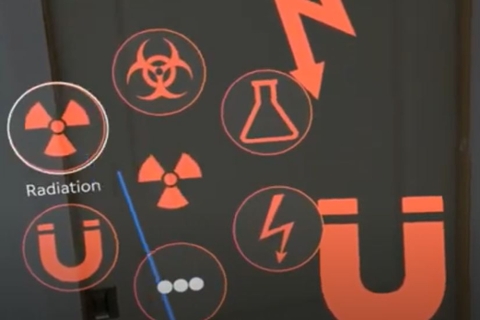 |
Using MR Technology to Aid Emergency Response Training
Team: Walter Lamar Ph.D.: Lead Researcher
Max Cacchione: Director of Innovation
Carolina Fernandez: Lead Programmer
Description: There exists the need to train staff and personnel to assure a proper response in cases of emergency evacuation namely, in cases where real-life simulations result impractical and/or costly (such is the case of smoke simulations).
This project consists of a Magic Leap app that displays building models and building information such as Electrical Panels Legends, Above Ceiling conduits, Medical Gas Piping Systems, and Utilities Shutoff Valves along with virtual smoke simulations to train staff and personnel in cases of emergency.
Video: https://youtu.be/dDKIA8WZfiQ
|
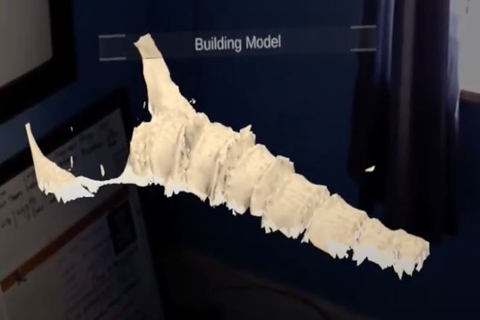 |
Wearable Heads-Up Display Based Mixed-Reality System for Interactive Image-Guided Neurosurgical Training and Surgical Procedures
Team: Michael Ivan: Primary Investigator
Timur Urakov: Primary Investigator
Max Cacchione: Innovate Team
Lenny Martinez: Innovate Team
Andrew Gonzalez: Innovate Team
Brandon Torres: Innovate Team
Manish Garg: Innovate Team
Aditya Bulusu: Innovate Team
Tiana Torkan: Innovate Team
Carolina Fernandez: Innovate Team
Description: Image-guided surgical procedures are highly technical in nature and require constant careful attention on the surgeon's part. We focus on building a system that integrates the current surgical navigation system (and associated surgical tools), registers locations of the surgical tools in relation to the surgical site, and provides visual feedback to the surgeon accordingly. This system will allow useful real-time integration to account for brain and bone shift as well as the incorporation of 3D digital pathology and 3D blood vessel flood dynamics. The system will be interactive as well as allow co-surgeons, residents, and other medical professionals to also visualize the surgeon's experience during the procedure allowing for improved education and interaction during surgery as well as most informed decisions for the surgeon during the procedure.
Video: https://youtu.be/dYn380ikD4k
|
 |
Mixed Reality to Tech Employment Skills for Individuals With ASD
Team: Anibal Gutierrez: Primary Investigator
Hammam Alsafrjalani: Primary Investigator
Yanerys Leon: Primary Investigator
Kim Grinfeder: Primary Investigator
Manouj Govindaraju: Developer
Description: Recent studies approximate that 1 in 59 children (over 23.8 million globally) is diagnosed with autism spectrum disorder (ASD). Individuals with ASD have difficulties in social interaction and communication and display patterns of restrictive or repetitive behavior. Although a significant amount of attention is given to early intervention for young children, many adolescents and adults with ASD continue to need support beyond school-age years. A group that is in particular need of support are individuals with ASD who are considered “high-functioning” and who would be able to work and live more independently with the correct supports. According to a recent study that surveyed adults with ASD, only 47% held paid employment and of those 72% only worked part-time and wanted more hours (Gotham et al., 2015).
Video: https://youtu.be/elyv9UzNPGA
|
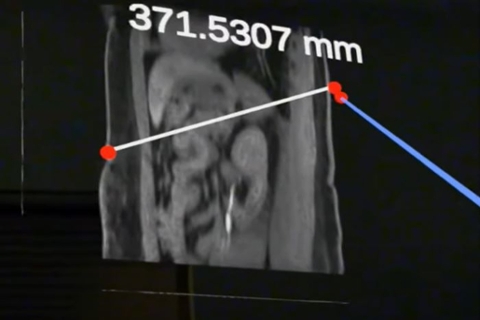 |
Volumetric Radiologic Data Viewer
Team: Harsh Shah MD
Thiago Braga MD
Kush Shah MD
Ediberto Alvarez MD
Description: Create a volumetric radiologic data viewer on an MR platform to view and interpret radiology images for the purposes of education, clinical decision making, and procedures.
Video: https://youtu.be/Y3dL6CwUMD8
|
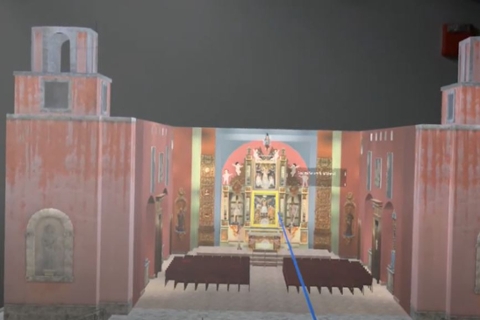 |
Experiencing Historic Architecture
Team: Dr. Karen Mathews: PI, Art historian
Chris Mader: Software Engineering, Photogrammetry
Amin Sarafraz: Software Engineering, Photogrammetry
Description: The church of Nuestra Señora de la Merced in the Miami neighborhood of Allapattah is a structure that has been renovated and decorated to resemble a historic Spanish Colonial church. This project aims to provide Magic Leap headset users with the opportunity to visit this building in two different spaces and modes: a virtual, more immersive experience outside the structure, and an enriched, AR experience inside the church itself. 3D models of the church’s interior and exterior will be uploaded to Unity to form the basis for the architectural experience application. In the first user scenario, a viewer can experience a fully immersive tour of the building wearing the goggles, walking around the building model on the exterior, viewing it from the top, and then visiting the structure’s interior. The virtual visit will allow the viewer to stop at points of interest and learn about these architectural elements through content generated by students in ARH 270 (Spanish Art). The second scenario entails using the headset in the church of Nuestra Señora itself, where a viewer’s experience of a Spanish Colonial interior will be augmented with data from other historic structures, allowing users to compare the artworks and architectural details in the church with structures and art collections worldwide, creating a personally-curated, virtual collection of artworks.
Video: https://youtu.be/5q4RM2UuEI8
|
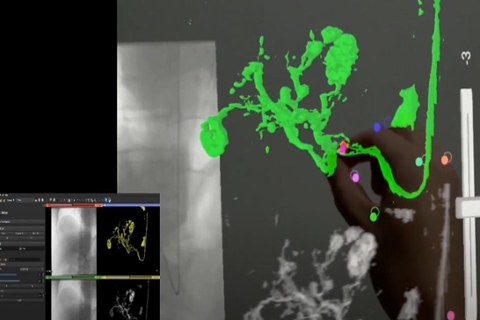 |
Magnification and Road Mapping in Fused Mixed-Reality Space for Image-Guided Procedures
Team: Doyoung Chang: Code Development
Shivank Bhatia: Clinical Advisor
Hamed Jalaeian: Clinical Advisor
Henry Cope: Coding Assistant
Description: The goal of this project is to develop a Magic Leap application to perform road mapping and digital zooming of angiography images that registers and overlays on top of the live fluoroscopy images during angiography. The developed application supports pan, zoom, re-slicing (from different angles), and semi-automatic fusion of high-resolution/high-contrast angiography images onto live 2D fluoroscopy images. Using this, the angiographer may reposition the catheter, magnify the image, or change the fluoroscopy image angle, while using the same reconstructed roadmap image in the AR space, without the need to repeat DSA images or give an additional dose of contrast which in turn reduces the total amount of administered intravenous contrast to the patient and the radiation exposure to both patient and interventional radiologist.
Video: https://youtu.be/iHzY5wEVDvw
|
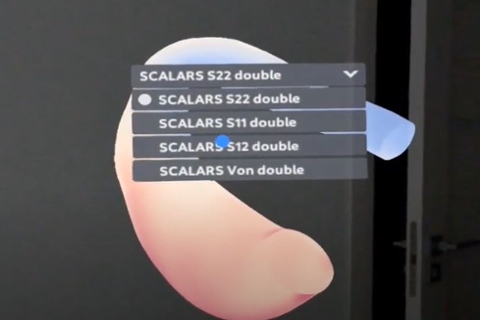 |
Mixed Reality Visualization of Aortic Aneurysm Diagnosis Results
Team: Liang Liang: PI, Project Design
Kristian Bouw: Programming
Description: This project was to develop a Magic Leap application to visualize aortic aneurysm diagnosis results: geometry and stress.
Video: https://youtu.be/o6Dn51RH6BQ
|
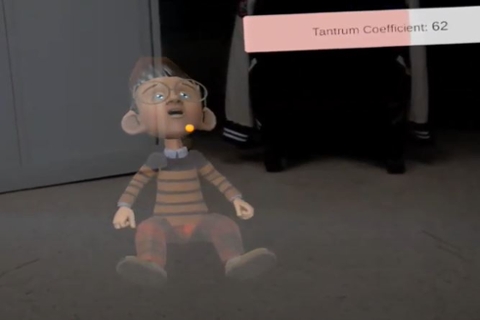 |
Learning to Manage Child Tantrums Using MR: An Innovative Tool to Teach Evidence-Based Behavior Management Strategies
Team: Angela Blizzard: Principal Investigator/Project Lead
Mei-Ling Shyu: Engineering Lead
Jason Jent: Content Expert
Yudong Tao: Magic Leap Engineering Developer
Dainelys Garcia: Content Expert
William Rothenberg: Content Expert
Description: We designed an MR simulation in which adults learn and practice behavior management strategies with a child avatar. In the first 5-minutes, adults learn effective positive attending (e.g., praising child behaviors) and selective ignoring skills to use during adult-child interactions. After the learning session, the adult enters a simulation in which a virtual avatar child has a tantrum. Based on the adult’s vocalizations and eye gaze, the tantrum escalates or deescalates.
Video: https://youtu.be/fUd2U3gbJuU
|
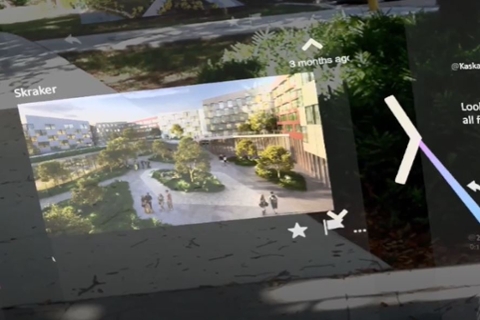 |
Wikipedia-AR
Team: Rodolphe el-Khoury: Research & Experience
Chris Chung: Research & Programming
Gemma Henderson: Educational/User Design
Sheng Qian: Production of 2D and 3D Content
Description: Tag-AR is a spatial social news aggregation, created, maintained, and edited by the University of Miami community. Tag-AR allows members of the University of Miami community to submit content such as text posts, images, links, videos, sound, and 3D models which are then tagged and spatialized across the University of Miami campus. Posts are then voted up and down by the community.
Video: https://youtu.be/H0EcSDmnCEY
|
 |
Machines of Loving Grace - A Magic Leap Trans-Experiential Art Installation
Team: Diana Arboleda: Administrator, Signal Acquisition and Control
Zeven Rodriguez: Co-PI; ML Developer
Monica Leslie Travis: Concept and Storyboard Design, Installation Design
Description: Machines of Loving Grace 1 (MOLG-1) is the first of an interactive time-based (4D) mixed reality (driven by biometrics) art experience intended for the general public and part of a larger interactive installation. The real components of the installation will include a recliner chair with a heartbeat (EKG) sensor, a brain activity (EEG) sensor, a newspaper rack with a fabricated newspaper containing galvanic skin response (GSR) sensors, and the Magic Leap headset (ML). The virtual components are the content of the newspaper and the hue in the room that appears overlaying the actual room.
Video: https://youtu.be/j92pn67aGnU
|
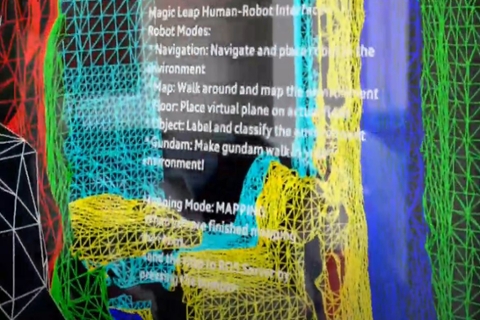 |
Intuitive Interface for Human-Robot Interaction
Team: Victor Milenkovic and Ubbo Visser: Principal Investigators
Pedro Pena: Magic Leap Implementation and Video
Joseph Masterjohn: Interface with ROS#
Description: The specific case study is robot caretakers for the elderly, but there will be many others. These robots will need to be personalized to the client’s home and special needs, such as how to help the client out of bed or where to find the client’s food or medicine. Unfortunately, there will never be enough experts in the domain, such as geriatric care, who are also capable of programming the robot directly. The proposed solution is to augment the geriatric expert with the Magic Leap and software that allows the expert to personalize the robot in an intuitive manner.
Video: https://youtu.be/NPGhPmmYCcg (Intuitive Interface for Human-Robot Interaction)
https://youtu.be/fJyUmySlKhI (Interface) Intuitive Interface for Human-Robot Interaction)
|
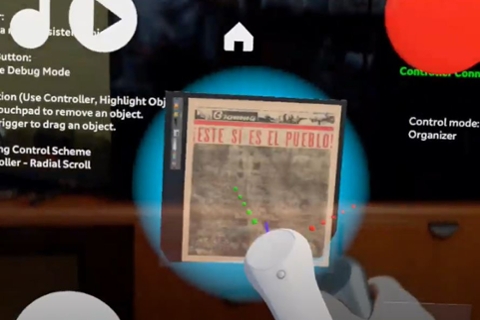 |
Voices of Mariel
Team: Elizabeth Cerejido: Provided academic knowledge
Jill Deupi: Provided a curatorial lens to the project
Mark Osterman: Digital engagement, user experience, assessment and evaluation
Charles Eckman: Contributed to information policy related to any open access initiatives
Vanessa Rodriguez: Provides technical guidance for the development of the app and testing equipment
Anthony Lou: Conducted computer coding
Description: We propose using Magic Leap to create an AR experience that will allow visitors to interact with exhibitions through visual and auditory experiences. We seek to use curated/recorded voices from individuals who experienced Mariel to animate a series of objects within the concurrent exhibits. In addition, we will leverage the device’s capabilities by recording visitors' own oral histories through prompts that are reactions to the exhibits and the material culture they encounter. These oral histories or “voices” will then be made available for other users to hear, creating a shared universe of voices of sound. This crowdsourced content will be stored on the AR cloud so that it is persistent and available. The immersive and interactive nature of the project expands the boundaries of the library and museum, connecting people and objects across time and space.
Video: https://youtu.be/Vo9sS6uYcRg
|
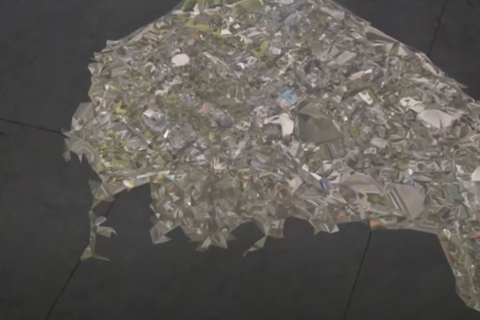 |
Tiling the Magicverse
Team: Timothy B Norris: PI and UI implementation
Chris Mader: Drone survey, application engineering advice
Amin Sarafraz: Photogrammetry
Kim Grinfeder: UI advice
Ty Feng: 3D tile creation
Steven Moncrief: UI implementation
Description: The rapid display of large and complex 3D datasets is a recognized problem in the visualization of geospatial data and 3D digital mapping. This problem is mostly due to hardware limitations of the devices on which the data is to be displayed; specifically processing power and memory capacity. Our project takes on this problem in the context of the Magic Leap 3D spatial computing augmented reality device. We met most of our project goals, or better said, we have prototypes of all the components that are needed to display large complex geospatial datasets in the Magic Leap device. At the same time, we encountered several problems that need further work to be fully resolved, for example, the segmenting of the data into manageable chunks functions in our prototype, but needs further improvement to be truly useful.
Video: https://youtu.be/bJZozL5YL1A
|
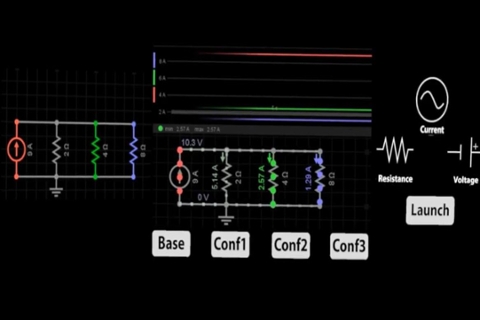 |
XR Circuits
Team: Jinqi Li, Hammam Alsafrjalani
Description: XR Circuits allows for circuits to be built and visualized easily with the help of an image target. Accessing real electronic circuits presents safety concerns and inconvenience. XR Circuits App recognizes image target and displays a corresponding electrical diagram, a simulation video, and a menu to change the circuit's electrical parameters in the headset. Students can change the value of parameters of the circuits in mixed reality and examine the effect current flow.
Video: https://www.youtube.com/watch?v=C3VWocYExRU
|
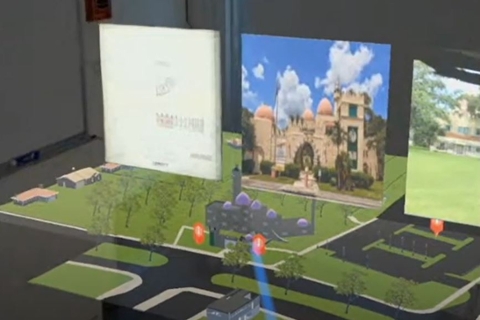 |
Porch Exhibit
Team: Shing Cheng, Germane Barnes, Gemma Henderson
Description: The Porch Exhibit project creates an easy to use template that allows architecture students to create augmented reality experiences without needing in-depth technical background knowledge. Porch Exhibit is a template created for the University of Miami's School of Architecture. The purpose of the app is to allow architecture students to easily display their models on a Magic Leap headset. The app includes the functionality to add buttons to the models which will: play audio, display text, or images. This app will help architecture students show off their designs at exhibitions by using the possibilities of augmented reality.
Video: https://www.youtube.com/watch?v=0DjRxIzLsto&feature=emb_logo; https://www.youtube.com/watch?v=IUIOxXlvhnc&feature=emb_logo
|
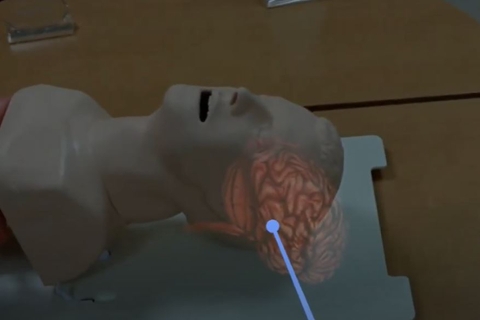 |
Medical Visualization
Team: Jiahao Zhou, Doctor X
Description: Medical Visualization is software that detects body organs and systems on wearable devices. The software cooperates with the human body model to allow the wearer to clearly understand the human body structure. In wearable devices, images are presented in 3D, giving people a clearer and more intuitive experience. This mixed reality application is for teaching staff to play any human organs and systems for students without using a large number of complex tools. In the software, you can present human organs and systems from any angle to achieve a perfect fit with the model.
Video: https://www.youtube.com/watch?v=ediDd4wHc6E&feature=emb_logo
|
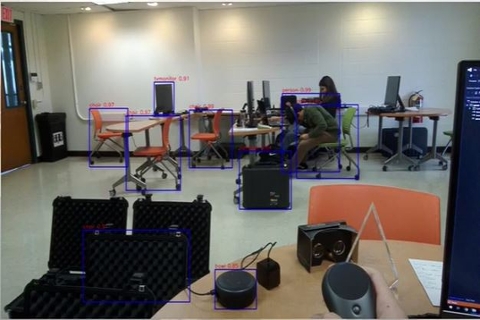 |
5G XR Image Recognition
Team: Berk Basarer, Hammam Alsafrjalani
Description: Image Recognition with Magic Leap using 5G capabilities for improved performance. Magic Leap is used to capture frames and send them to a python machine learning server, which in turn will process and send the results back to Magic Leap. Then the device will represent these results on the original image that is taken to show the user the processed image.
Video: https://www.youtube.com/watch?v=9a2F4mWsTDM&feature=emb_logo
|
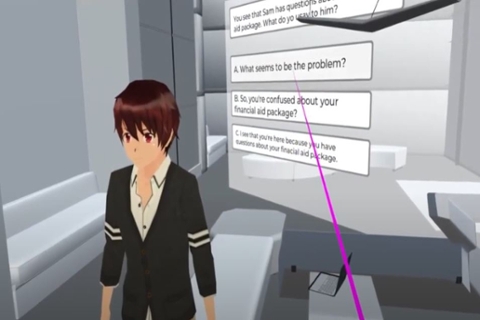 |
Canes Central Visual Trainer
Team: Marcia Beckford
Description: A Magic Leap XR app that guide faculty, staff, and students to familiarize themselves with the new building. The app is designed to give a step-by-step interactive virtual tutorial.
Video: https://www.youtube.com/watch?v=RFTvcjffjmM
|
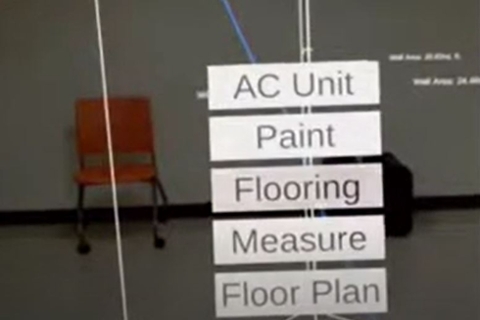 |
ARchitech
Team: Carolina Fernandez, Rodolphe el-Khoury, Chris Chung
Description: ARchitech is a Magic Leap app that allows you to create floor plans of your home and receive home furniture purchase recommendations from sales partners. It includes capabilities such as measuring architectural elements, producing floor plans, researching standard sizes, and purchasing products from commercial partner. The benefits of ARchitech are in commercial application, partnership opportunities, and student learning.
Video: https://www.youtube.com/watch?v=N4yJv5Xg15w&feature=emb_logo
|
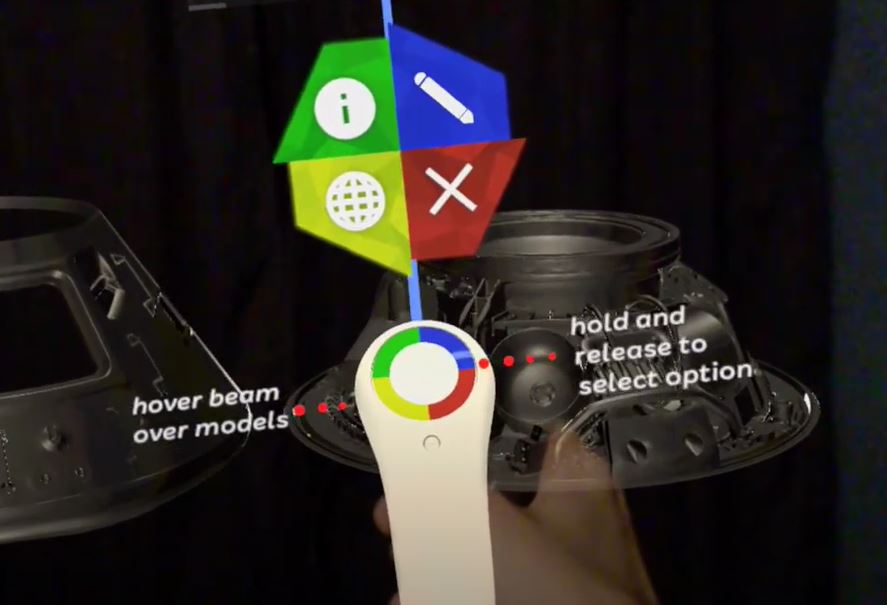 |
Uniloader
Team: Andrew Gonzalez, Manish Garg
Description: University of Miami Innovate team, in collaboration with the University of Miami, the Uniloader web application that will be accessible to any member of the university, faculty, students and staff. By uploading a model to the Uniloader, users could visualize them in 3D instantaneously using the Magic Leap headset. Users will have the opportunity to use this application across the UM campuses and at home for distance learning courses.
Video: https://youtu.be/mhOA5kfyW1Y;
https://youtu.be/uqKwzxYy0Aw
|
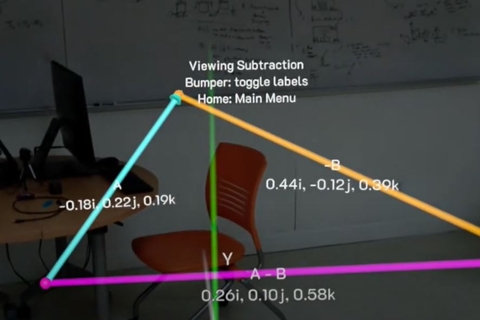 |
Vector in Space Module 3
Team: Rachel De Paz, Aaron Geldert, Dr. Diana Arboleda
Description: Vectors in Space is a Magic Leap app designed for students to understand how vectors are represented in 3D space. Students who start a course of study in Engineering Statics must complete a two week math refresher period. A large portion of this math refresher period is spent on vectors. Students sometimes experience difficulty visualizing vectors in 3D.This mixed reality application allows the professor and students to draw, examine, and perform operations with 3D vectors in a real space.
Video: https://www.youtube.com/watch?time_continue=18&v=0D4n9Lw-5uk ; https://www.youtube.com/watch?v=Sonbx1nAVRI&feature=emb_logo
|
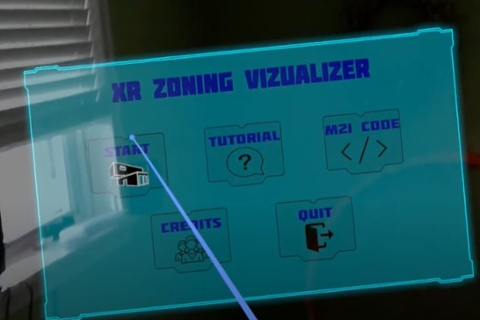 |
AR City
Team: Juan Alayo, Samuel Garry, Samantha Kamath, Milena Pak
Description: A cutting edge application that will be able to translate the GIS zoning data for the City of Miami Zoning Code into an on-site XR environment.
Video: https://youtu.be/Khz5Yw2_H-E
|
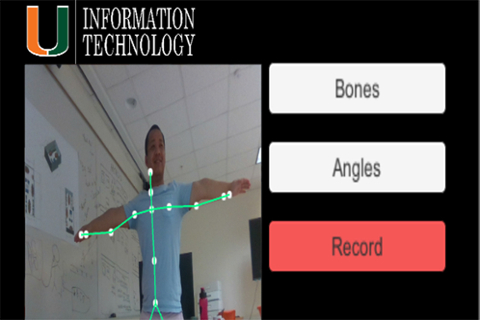 |
Mixed Reality Bio Mechanist
Team: Shing Cheng, Prajwal Devokta, Harisson Mount, Moataz Eltoukhy
Description: Mixed Reality Bio mechanist is an app that allows you to visualize a person's kinematics as a dynamic overlay. This desktop app can be highly beneficial as a tool used by healthcare professionals and students alike for complete mobile movement assessment easily used in clinic and office settings. A valuable tool for classrooms to teach students essential human body mechanics, specifically joints' and osteo- and arthro-kinematics. Research focused mainly on validating the app against the gold-standard motion capture system (Vicon) to investigate the possibility of introducing this tool as a valid clinical movement assessment tool.
|






























